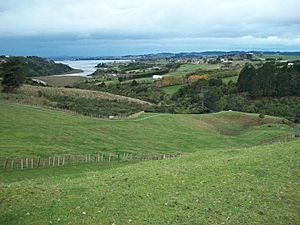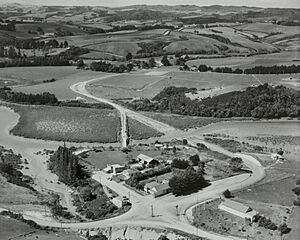Whitford, New Zealand facts for kids
Quick facts for kids
Whitford
|
|
|---|---|

The Pacific Coast highway near Whitford has views of the surrounding countryside, farms, and Hauraki Gulf
|
|
| Country | New Zealand |
| Region | Auckland Region |
| Ward | Franklin ward |
| Board | Franklin Local Board |
| Electorates |
|
| Area | |
| • Total | 0.18 km2 (0.07 sq mi) |
| Population
(June 2023)
|
|
| • Total | 110 |
| • Density | 610/km2 (1,580/sq mi) |
Whitford is a small, quiet town located southeast of Auckland, New Zealand. It's part of the beautiful Pōhutukawa Coast, known for its stunning views. This area is special to Ngāi Tai ki Tāmaki, the local Māori people, who have lived around the Turanga Creek for a very long time. In the 1800s, Whitford grew into a farming town, famous for its ostriches, racehorses, and a large quarry.
Contents
Where is Whitford Located?
Whitford is found at the end of the Turanga Creek, which is like a river arm connected to the Hauraki Gulf. It's about 20 kilometers southeast of the main Auckland City Centre.
What's in a Name?
Before 1882, European settlers called this area Turanga. The name Whitford has a few possible stories:
- It might be named after Richard Whitford, who ran a flax mill nearby and delivered mail.
- Another idea is that it comes from a "White-ford" (a shallow place to cross a river) over the Turanga Creek. When the tide was out, the salt would dry, making the crossing look white.
- It could also be named after Whitefoord Park. This was a large property that later became known as Whitford Park when it was divided up for sale in 1903.
Whitford's Rich History
The Pōhutukawa Coast has a long history. Around the year 1300, the Tainui canoe, a traditional Māori boat, landed at Tūranga Creek. They tied their canoe to a special rock shaped like a person, which is how the creek got its name, meaning "Anchorage."
Some of the Tainui travelers, known as Ngā Oho, decided to stay and live between the Pōhutukawa Coast and Tūwakamana (Cockle Bay). The Ngāi Tai ki Tāmaki people, who are the traditional guardians of this land, are descendants of these early settlers. Their stories tell of a magical people called Tūrehu who lived here before them. Many local place names, like Hinerangi and Manawatere, are linked to these Tūrehu figures.
The Tūranga Creek area was a very important place for food. People would gather eels (tuna), lampreys (kanakana), flounder (pātiki), and kererū (native pigeons). There were many traditional villages (kāinga) and fortified settlements (pā) here, including Moananui and Mangemangeroa.
In 1833, when William Thomas Fairburn visited, the area was mostly empty because of the Musket Wars. Many Ngāi Tai people had moved to the Waikato for safety. Later, in 1836, Fairburn bought a huge piece of land. However, the government decided he bought too much, and some of the land was not returned to Ngāi Tai. Instead, a special reserve was created for them in 1854 near Umupuia.
Whitford's first European settlers, George and William Trice, arrived from Kent in England in 1841. They started a very successful farm in 1843, growing mostly potatoes and hiring local Ngāi Tai people to help. Their farm eventually grew to 1,000 acres. They also tried to find gold, but that didn't work out. Their gold mine later became the Whitford Quarry.
More settlers arrived in the mid-1850s. In the 1860s, a wooden bridge was built over the Mangemangeroa Creek, making it easier to travel to Auckland by road. Even with the bridge, most people traveled by water until the 1920s, when roads and cars became more common.
During the Invasion of the Waikato in 1863, the Ngāi Tai village of Ōtau was attacked. The villagers had to leave their homes and live near the river's mouth. The Ngāi Tai people were considered "friendly" by the government and stayed neutral in the fighting. After the Native Lands Act of 1865, much of the Ngāi Tai land was taken by the government and then sold to European farmers.
Whitford as a Farming Town
In 1869, the Nathan family took over a farm and started an ostrich farm. They raised ostriches for their meat and feathers, which were popular in fashion until the 1920s. Whitford also became a place where racehorses were trained. In the 1890s, the Nathan family had a large horse racing track, and people from Auckland would come by ferry to watch the races.
The farmers in Whitford mainly grew oats, hay, wheat, and potatoes to sell in Auckland. A brickworks operated in the town from 1878 to 1920, and in 1900, the Nathan family opened a butter factory.
In 1910, the Nathan family divided their large farm into 21 smaller farms, which helped the Whitford community grow even more. Whitford Hall was built in 1912. During the Great Depression (1929-1934), the town had camps for unemployed people, who worked at the Whitford Quarry.
During World War II, local home guard troops dug trenches and built tank traps around Whitford to protect the area. In 1957, the Whitford Domain was opened as a sports field and a memorial to those who served in the war.
By the early 2000s, Whitford had become a service center for the farms around it. It also became a place where people lived and commuted to work in the city. Because nearby areas like Beachlands and Ormiston have grown a lot, Whitford village now sees much more traffic.
Whitford's Population
Statistics New Zealand describes Whitford as a rural settlement. In 2018, it had an estimated population of about 147 people.
The local area, which includes Whitford, had a population of 147 people in the 2018 New Zealand census. This was a small decrease from 2013 but an increase since 2006. There were 45 households, with slightly more males than females. The average age was 46.7 years.
- About 18.4% of the people were under 15 years old.
- Most people (87.8%) were of European background.
- About 12.2% were Māori.
- Many people (44.9%) said they had no religion, while 40.8% were Christian.
The average income in Whitford was $45,400, which was higher than the national average. Most adults were employed full-time.
Places to See in Whitford

- Ayrlies Garden: This is one of New Zealand's most famous gardens and is located right here in Whitford. It's a beautiful place to explore.
- Wades Walkway: This walking path starts in Whitford and follows the western side of the Turanga Creek, offering nice views.
- Granger Chimney: This old chimney is a leftover from the Granger's Brick and Tile Works. It's a well-known landmark in the area.
- William Granger Brick House: This house was built for William Granger. After the brickworks closed, it became a farmhouse and was restored in the 1970s.




